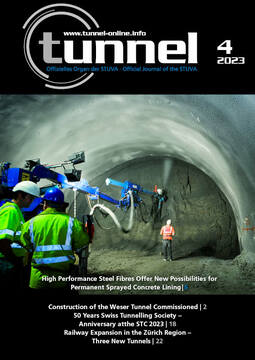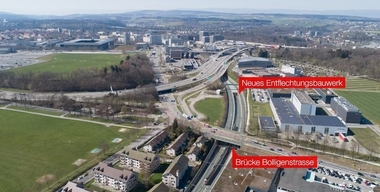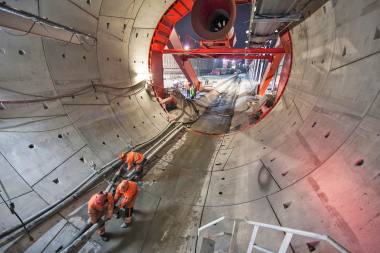Railway Expansion in the Zürich Region: The SBB Is Building Three New Tunnels
Projections for the greater Zürich area indicate a 30% increase in demand for rail transport by 2050. To cope with this increase, three major projects – Zimmerberg Base Tunnel 2, Zürich Stadelhofen Expansion and Zürich–Winterthur Multitrack Expansion – will be implemented in the 2035 expansion phase at a cost of around five billion Swiss francs. (This article was part of the conference programme at the Swiss Tunnel Congress 2023 in Lucerne.)
1 Project Development Until 2035
In order to cope with the growing demand for rail transport, the Swiss federal government intends to further expand the Swiss rail network via a 2035 rail expansion project. The forecast demand has been met with a corresponding offer. To implement this offer, it is necessary to expand railway infrastructure, which will be realised in the next 15 years. With the confirmation of the 2035 expansion stage, parliament approved a comprehensive development programme for a total of 12.89 billion Swiss francs.
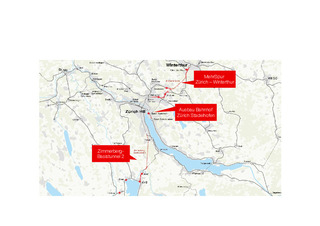 1 Three major projects in the Zürich area will bring more capacity and stability to rail traffic
1 Three major projects in the Zürich area will bring more capacity and stability to rail traffic
Credit/Quelle: SBB
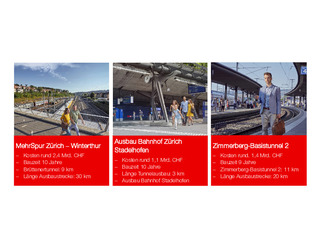 2 Tunnels help expand railway networks
2 Tunnels help expand railway networks
Credit/Quelle: SBB
For rail traffic in the greater Zürich area, forecasts assume a 30 % increase in demand by 2050. In order to cope with this increase, three major projects will be implemented in the Zürich area in the 2035 rail expansion phase (Fig. 1 and Fig. 2). These projects will eliminate critical congestion in the railway network, which currently limits both capacity and scheduling stability. With the Zimmerberg Base Tunnel 2, the two single-track sections between Horgen Oberdorf and Litti on the Zürich-Zug axis will be supplemented by a new double track. This will be routed through two 10.8 km long single-track tubes. The Zimmerberg Base Tunnel 2 – together with a third track between Baar and Zug, which will also soon be built, as well as extensions in Cham and Rotkreuz – will not only save travel time, but will also increase longdistance services between Zürich and Central Switzerland (quarter-hourly intervals) and Ticino (half-hourly intervals). A fourth platform track will be built at the Zürich Stadelhofen station and a second tunnel to Tiefenbrunnen will be excavated. With 32 train lines per hour travelling in each direction, this will create continuous capacity on the main Zürich S-Bahn axis between Zürich Hardbrücke and Zürich
Stadelhofen. In the “Zürich–Winterthur Multitrack” project, the Swiss Federal Railway (SBB) will construct an additional double track between Wallisellen/Dietlikon and Bassersdorf and Winterthur, which will run through the new Brüttener Tunnel. The capacity of the line between Zürich and Winterthur will thus increase from 670 to 900 trains per day. The two projects “Zürich Stadelhofen Station Expansion” and “Zürich–Winterthur Multitrack” will enable substantial expansion of services on the Zürich – Winterthur axis and further into north-eastern Switzerland, both for national long-distance traffic and for Zürich’s S-Bahn. Freight traffic will also benefit from a higher number of train routes – twice an hour in the direction of Gossau and twice an hour in the direction of Romanshorn from and to the Limmattal marshalling yard.
2 Project Organisation
The FOT (Federal Office of Transport) has commissioned the SBB to implement these three major projects. The costs for all three projects are estimated at around 5 billion Swiss francs, based on 2018 prices. The implementation timeframe is around 10 years. The projects are currently in the preliminary project phase (Zimmerberg), the project planning phase (Stadelhofen) and the public launch phase (Multitrack) (Fig. 3).
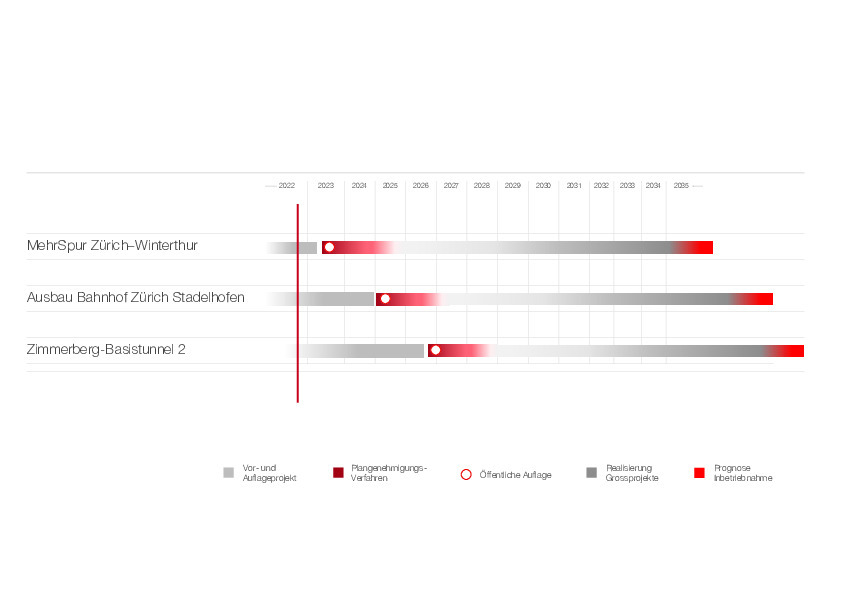 3 Risk-based, large-scale project planning om a rolling basis
3 Risk-based, large-scale project planning om a rolling basis
Credit/Quelle: SBB
The SBB has set up its own project organisation to plan and implement these three major projects in accordance with the FOT’s specifications, both in terms of costs and deadlines. The project organisation ensures that the extensive construction work is coordinated in the best possible way. This should ensure that there is sufficient capacity in the railway network at all times to handle ongoing railway operations in a stable and reliable manner. Finally, the project organisation ensures that the newly constructed facilities are integrated into the railway system and that the SBB is able to reliably provide the expanded service until the facilities are put into operation. Operational organisations relating to passenger and freight traffic, service planning, operations management, intervention and maintaining the SBB are therefore integrated into the project organisation.
3 Organisational, Operational and Technical Challenges
3.1 Zimmerberg Base Tunnel 2
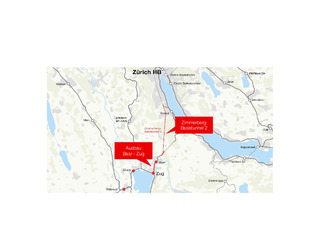 4 Zug cantonal extensions and the Zimmerberg Base Tunnel 2 enhance Zürich–Lucerne train services
4 Zug cantonal extensions and the Zimmerberg Base Tunnel 2 enhance Zürich–Lucerne train services
Credit/Quelle: SBB
The existing Zürich-Thalwil double-track tunnel will be extended by two 10.8-km-long single-track tubes in the direction of Zugerland (Fig. 4). The original connecting structure can be used to connect to the existing tunnel. The new tunnel’s southern portal will be located in Litti, just outside Baar. Long-distance trains between Zürich and Lucerne, as well as to Ticino, will bypass Thalwil in the tunnel in the future, saving several minutes of travel time. The existing line from Horgen Oberdorf to Baar with the two Zimmerberg and Albis single-track tunnels will continue to be used for regional traffic and during maintenance work in the base tunnel.
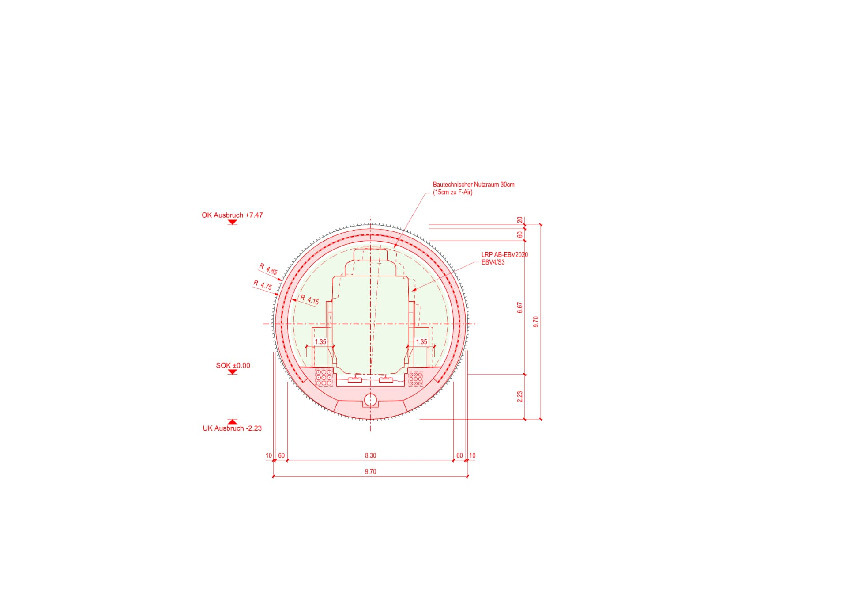 5 Single-track, double lined tunnel constructed using TBM
5 Single-track, double lined tunnel constructed using TBM
Credit/Quelle: SBB
The two Zimmerberg Base Tunnel 2 tubes (Fig. 5) will be mechanically excavated from the south. Most of them are located in the upper freshwater moraine, which is a wellknown area from other projects; this means that no major difficulties are expected during excavation. Around 2 million cubic metres of excavated material will be produced at the south portal. This material will be deposited on site to avoid transport to landfills and to save costs. Terrain modelling combined with covering sections of the motorway is planned. The spatial planning specifications for this project are already being made with the federal government and the cantons before starting the plan approval procedure. According to the current assessment, construction of the Zimmerberg Base Tunnel 2 is a manageable, clearly defined and rather low-risk project. The SBB will therefore also examine alternative contract models (GU+ or TU) for the realisation of the tunnel and, if necessary, tender the overall performance on the basis of the preliminary project.
With the commissioning of the Zimmerberg Base Tunnel 2, the double-track tunnel built in the 1990s, will become
part of a new tunnel system almost 20 km in length – with a connection in Thalwil. Accordingly, the operation, maintenance and emergency concepts will also have to be revised in accordance with the specifications that will
apply in the future. While the existing double-track tunnel has three emergency exits at intervals of between 2 and 3 km, the new tunnel will be built in two single-track tubes with cross-passages every 500 m for emergency intervention and rescue options. Because the length between the Zürich and Litti portals is less than 20 km, an emergency station in the tunnel can be omitted according to the current information at hand. However, facilities for emergency intervention and evacuation are required at the portal entrances.
3.2 Zürich Stadelhofen Expansion
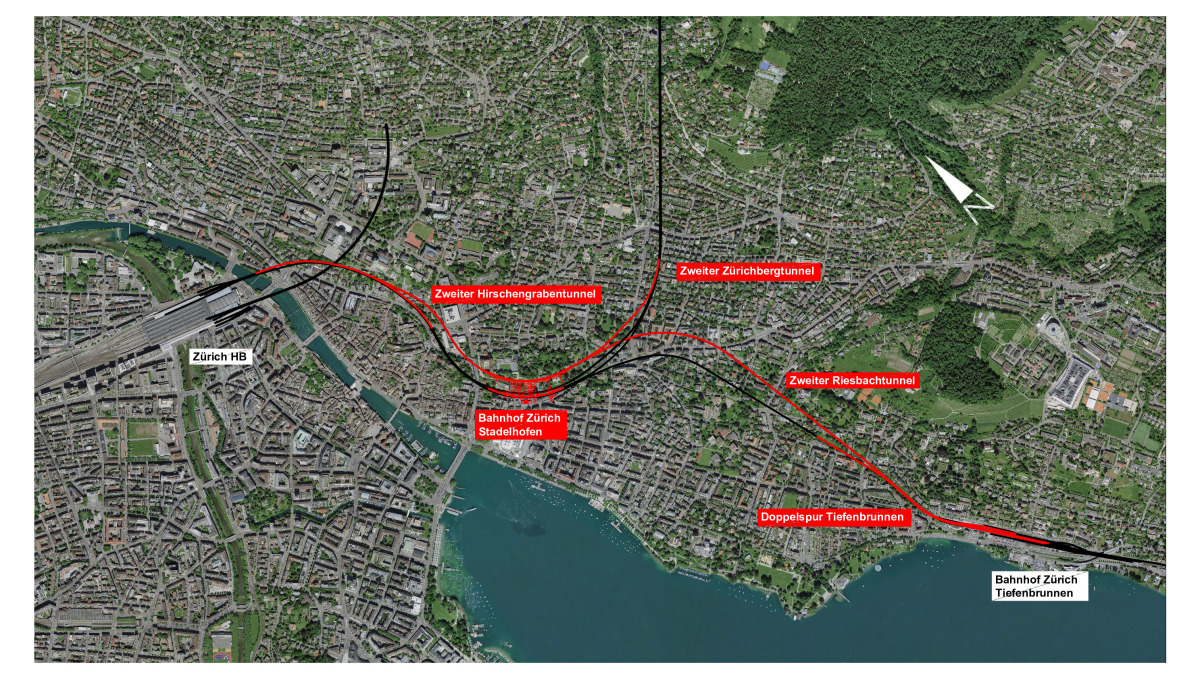 6 Increased capacity due to extending the Zürich Stadelhofen and building a double track
6 Increased capacity due to extending the Zürich Stadelhofen and building a double track
Credit/Quelle: SBB
The Zürich Stadelhofen station is part of the double-track Zürich S-Bahn main line (Fig. 6). While the Zürich Hardbrücke and Zürich Museumstrasse stations have four tracks, the current Zürich Stadelhofen station only has three platform tracks. In addition, the connecting line in the direction of Tiefenbrunnen-Meilen, with the Riesbach Tunnel, is only a single-track. This means that the Zürich Stadelhofen station is a significant bottleneck in the Zürich S-Bahn network and must be expanded in order to further develop the service.
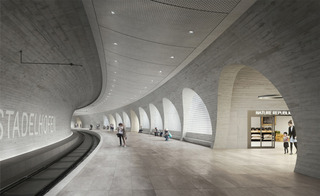 7 The Zürich Stadelhofen station, new platform hall, platform 4
7 The Zürich Stadelhofen station, new platform hall, platform 4
Credit/Quelle: SBB
The fourth track will be constructed in a 320-m-long and 14-m-wide train station platform hall 40 m down the mountain and will be accessible via several passages from the existing underground passage. The project was selected through a competition (Fig. 7). It only requires minor interventions in the existing structure of the Zürich Stadelhofen station and enables construction to take place largely outside the public area. The new platform track will be integrated into the existing double-track tunnel on both sides: on the Zürich side into the Hirschengraben tunnel and on the Stettbach side into the Zürichberg Tunnel. The second Riesbach Tunnel, which is also part of the project, leads from the junction structure east of the platform hall to Tiefenbrunnen.
A total tunnel length of 3.1 km will be excavated for the fourth track. This will create a new, coherent tunnel system with a total length of 11.6 km – extending from Museumstrasse station to Stettbach and Tiefenbrunnen.
From a structural engineering point of view, the “Zürich Stadelhofen station extension” project is very demanding. The standard profile of the approximately 330-m-long tunnel designed to accommodate the new fourth track, including the passenger platform, has an excavation area of approximately 170 m². The construction logistics are carried out via two construction chambers located north and south of the station.
In order to construct the new underground facilities, including access to the fourth track, around 250 rear wall anchor bolts behind the current track 3 must be re-drilled in advance. To avoid settlements in the relevant glacially pre-stressed loose rock, comprehensive construction support measures have to be taken. From the point of view of railway operations, the two structures connecting to the existing double-track tubes and the double-track extension in the excavated Tiefenbrunnen area are key elements. Operational restrictions on the Zürich S-Bahn main line between the Museumstrasse and Stettbach stations are only possible at night or on a few weekends. Therefore, in the tunnel junction area, a protective tunnel will first be installed inside the double-track tunnel. Excavation of the junction chamber will take place from back access tunnels around the existing tunnel. Only when the cavern is completely secured and removed will the old tunnel vault be demolished, the protective tunnel removed and the connecting switch installed.
In addition to the construction challenges, the project is also characterised by inner-city boundary conditions. Workers mainly access the underground construction sites via two large construction shafts and via the Riesbach tunnel excavation in Tiefenbrunnen, which starts from the portal. The excavated material is disposed of via the Tiefenbrunnen railway station. The material is either taken away by rail in the direction of Rapperswil, or it can be used to create new shallow water zones in the Zürich lakeshore area. Since the underground structures have minimal cover, the buildings and properties above them are also affected in a variety of ways: transfer of rights, conflicts with earth sensors, vibrations or sedimentation. Together with the affected owners and residents, the SBB is trying to find solutions that have minimum emissions and maximum public acceptance.
3.3 Zürich–Winterthur Multitrack Project
With the project “Zürich–Winterthur Multitrack” project, the federal government and the SBB are planning a new doubletrack railway line through the Brüttener Tunnel and to expand the Dietlikon, Bassersdorf, Wallisellen and Winterthur Töss stations. This will make it possible to eliminate the current bottleneck in the rail network between Zürich and Winterthur and provide necessary service expansion.
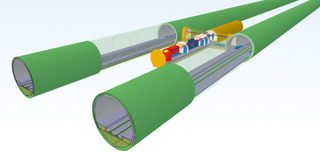 8 Twenty cross-connections used as technical rooms and escape route
8 Twenty cross-connections used as technical rooms and escape route
Credit/Quelle: SBB
The Brüttener Tunnel is designed in a Y shape with a portal on the Winterthur side, the underground Mülberg junction and two portals on the Zürich side. The tunnel is 8.3 km long between the Dietlikon and Winterthur portals, with the junction in the direction of Bassersdorf measuring an additional 0.9 km. The project team chose two single-track tubes as the cross-section, resulting in a total tunnel length of 18.4 km. Excavation of the tunnel from the Dietlikon portal will probably be carried out using a tunnel boring machine with a diameter of around 10 m. This will be followed by laying concrete segments, full-surface sealing and laying the concrete inner lining. The two tunnel tubes are about 20 m apart and are connected to each other every 500 m by cross passages. Technical rooms, in which the power supply and communication facilities are housed, are connected to the cross passages. In the event of an incident, the cross passages can serve as escape routes (Fig. 8). For the tunnel’s supplies (ventilation, electricity, telecommunications and drainage) and as access for maintenance staff, three underground, multi-storey railway engineering buildings will be located near the portal.
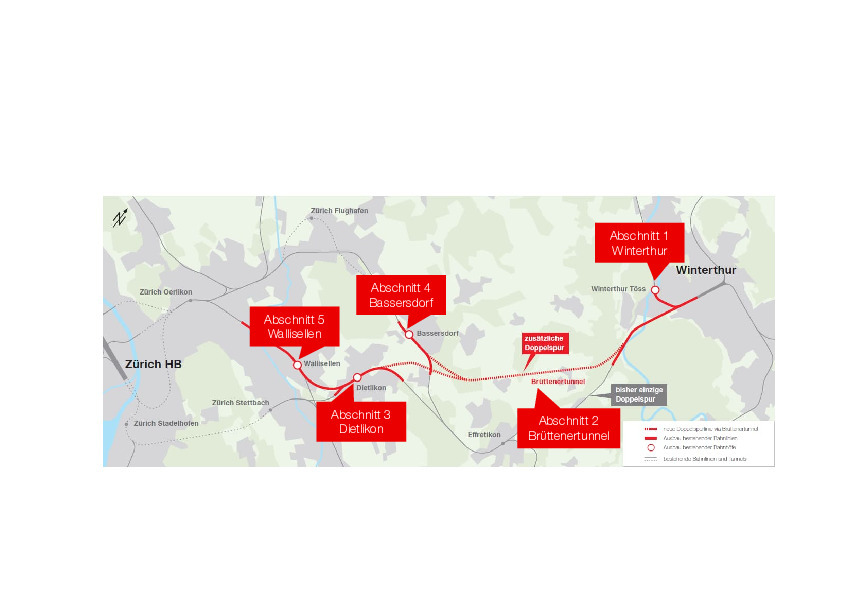 9 Necessary relief with new double-track lines through the Brüttener Tunnel and expansion of four stations
9 Necessary relief with new double-track lines through the Brüttener Tunnel and expansion of four stations
Credit/Quelle: SBB
The “Zürich–Winterthur Multitrack” project’s perimeter extends far beyond just the tunnel portals. It stretches from Oerlikon via Wallisellen and Dietlikon and from Kloten and Bassersdorf in the west to the start of the platform at the Winterthur station (Fig. 9). The Brüttener Tunnel, with a length of about 9 km, therefore only accounts for about one third of the total length of the 30-km-long project. In terms of costs, about 40 % of the total project costs will be spent on the tunnel structure. The large project perimeter is necessary in order to increase the efficiency of the railway network between Zürich and Winterthur and to make the best possible use of the new double track tunnel’s capacity. A total of eight new, grade-separated unbundling structures, such as bridges or tunnels of 300 to 700 m in length and overpasses at the tunnel portals, will enable conflict-free routing of various long-distance and suburban trains, as well as freight traffic between Zürich and Winterthur. In addition to the additional capacity, the unbundling structures will also make a significant contribution to the stability of rail operations by resolving potential crossing conflicts. Implementing the unbundling structures requires significant changes to the track’s topology throughout the entire project area, which means the railway facilities in Wallisellen, Dietlikon, Bassersdorf and Winterthur on the Zürich side have to be completely rebuilt. Four signal boxes will be built and 150 new switches will be installed. Constructing the new facilities without interrupting rail operations is a major challenge and requires careful planning and extensive safety measures. Planning for the current construction phases foresees around 150 construction phases. The railway services must be maintained during the construction phases, with reduced train services in the off-peak hours being unavoidable. Weekend closures or longer disruptions during summer holidays are also planned for major reconstruction work, when alternative services will be available to customers.
4 Conclusion
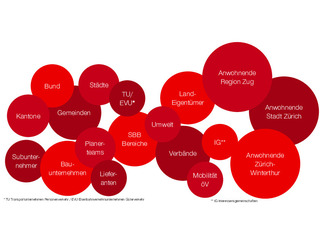 10 Many project stakeholders require a high degree of coordination
10 Many project stakeholders require a high degree of coordination
Credit/Quelle: SBB
When it comes to expanding a railway, many different challenges need to be met. They range from finding technical solutions to mastering logistics and ensuring ongoing railway operations to winning acceptance for the project among stakeholders and the public (Fig. 10). Only a diverse team of planners, contractors, suppliers, partners and clients, who cover all the required competences, are focused on the common goal and respect each other’s interests, can successfully achieve such complex projects.

